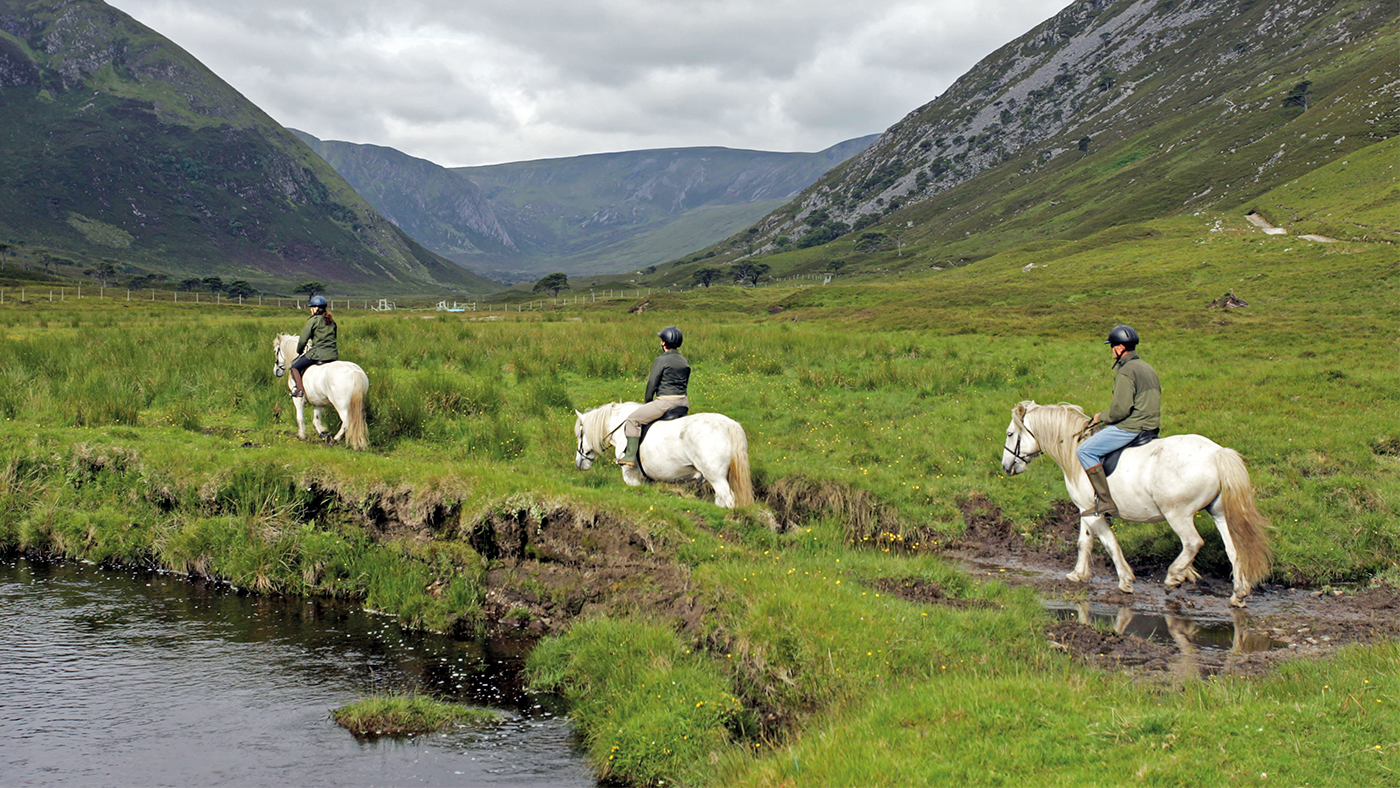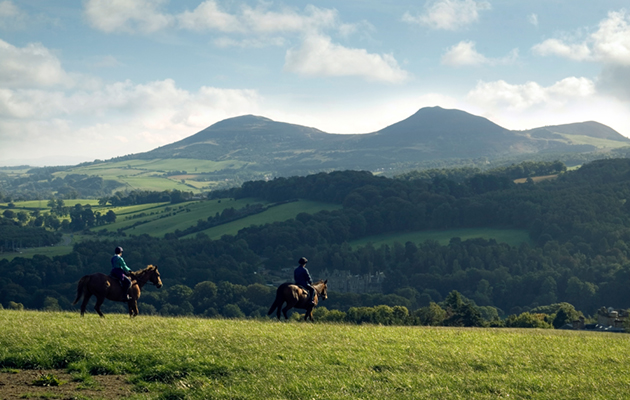Whether planning a holiday or moving lock, stock and barrel, discover the best of Scotland with its Caribbean-style beaches, terrific training terrain and popular native breeds, says Becky Murray
THERE’S something majestic about Scotland, a land like no other. Home to native breeds including the much-loved Clydesdale and the Eriskay pony, Scotland is famed for its scenery and visitors are welcomed with open arms to a unique sense of camaraderie.
But a proud Scot can be a force to be reckoned with and when it comes to equestrianism, they rightly have much to be proud of with top studs, medal-winning riders, and training grounds producing past and future success stories. The long, harsh winters and often lengthy travel to competitions certainly teach riders about grit and determination, but combined with breathtaking views and islands that offer Caribbean-like beaches, there are worse places in the world to be an equestrian.
A dressage rider who knows a lot about this determination is 19-year-old Rachel Evans, who lives in Shapinsay, a small island off Orkney. Despite there being no British Dressage competitions in Orkney, she qualified for the 2020 Petplan Equine Area Festival Championships at Hartpury (which were later cancelled owing to Covid) with her Connemara gelding Kingswells Midnight Blue. Rachel has her eye on further qualifications and is training towards advanced medium level.
“I don’t have an arena so I have to school on the beach,” explains Rachel, who travels to mainland Scotland throughout the year for training and competition. “I have to ride when others might choose not to, you have to make the most of it. There’s usually one unaffiliated competition in Orkney a month, but because I’m not on the mainland of Orkney it’s still a 25-minute boat journey to get there… and the boat doesn’t run if the weather is too bad!
“When the weather is nice, there is no better place to be. The roads are quiet so the hacking is really good, and you know that if there was a problem anyone would help you.”
IT’S not just riders made of the tough stuff. Born to cope with harsh island life of course is the robust Shetland pony, which has long inhabited the Shetland Isles and can be traced back to the Bronze Age. While this native breed might be small, it packs a punch with personality and ability, and has become a popular children’s pony across the world, starting the careers of the likes of eventer Zara Tindall and jockey Sam Twiston-Davies.
Elaine Tait of the Merkisayre Shetland Pony Stud, formed by her parents Barbara and George in 1994, says while the ponies thrive on the island, they are also very versatile to live elsewhere and turn their hooves to a variety of careers. One of the stud’s most recent success stories is Merkisayre See Duble, who competed in the Shetland Pony Grand National final at Olympia, the London International Horse Show, in 2018 with his jockey Poppy Dadson.
“It’s very nice when you get a phone call to say a pony you’ve bred has won a championship or qualified somewhere,” says Elaine, who herself competed at Olympia on her Shetland pony Robins Brae Firva in 1987 and 1988. “It’s good to hear they’re successful because that means you’ve done a good job.”
Another much-loved native Scottish breed is the Highland pony, known for their kind temperament and strength. The Queen’s Highland pony stud at Balmoral Castle breeds working ponies for carrying stags off the hills of the estate – as well as producing successful ponies for the show ring. The stud has a herd of 40, including stallions Balmoral Squire and Balmoral Major.
“What we think about first and foremost, especially for a working breed, is the brain; if they don’t have the temperament with a trainable brain, there’s no point even starting,” explains Sylvia Ormiston, Balmoral Stud manager. “Her Majesty The Queen is very involved in our breeding programme – I will come up with a suggestion and take it to The Queen and she’ll either agree or disagree whether she wants to go ahead.”
IT isn’t just native breeds flying the Scottish flag; sport horse studs including Balcormo Stud, MFS Studfarm, Turnbull Ashton Stud and Caledonia Dressage Horses are among those with lots to shout about as their horses enjoy worldwide success.
The Low-Mitchells’ Balcormo Stud was home to the late breeding stallion Secundus, one of the first warmbloods to arrive in Scotland, imported by the late Dugald Low-Mitchell. He promptly put Scottish breeding on the map with countless offspring competing internationally. The stud continues to breed successful horses from stallions Corraghoe Storm and Jumped Up Z.
Sandra Low-Mitchell says she’s proud to be Scottish and describes the landscape as a “playground” for educating young horses.
“It’s a great starting ground in terms of the variation in the climate, ground and terrain, but I think when you get to a certain level you have to take a chance and move on and get out into the world,” she explains. “Scott Brash has been a fantastic inspiration for riders – he’s shown it can be done. He always had serious talent, but he also has fantastic drive.”
COMPETITORS in Scotland have a choice of venues offering British Showjumping and British Dressage including the Cabin Equestrian Centre, Aberdeenshire; Howe Equestrian,
Fife; the Scottish National Equestrian Centre, West Lothian; and Morris Equestrian Centre and Muirmill Equestrian Centre, East Ayrshire.
The British Eventing offering in Scotland has reduced in recent years as organisers have retired or moved away from affiliated events with competitor favourites Aswanley, Floors Castle and Eglinton some of the events to drop off the calendar.
Burgie, Hopetoun, and Kirriemuir are among those that continue to welcome riders during the limited Scottish season.
And while competitors aspiring to the higher levels often spend many hours on the road heading south, the Royal Highland Show and Blair Castle International Horse Trials pull in the cream of the crop up north, as top showing riders, showjumpers and eventers descend annually.
“The Royal Highland is a big draw for us, everyone wants to ride there – it has a great atmosphere and you don’t get a nicer place than Blair Castle,” says Sandra.
New Zealand Olympic rider Caroline Powell, who was based in Scotland for almost 20 years, has fond memories of Blair Castle.
“Blair was amazing – they had some excellent events,” she recalls. “It certainly isn’t a place to go with horses that don’t know how to get up and down hills!
“I miss Scotland and the camaraderie, it had a close-knit community and was good fun. Kelso was a lovely place to keep horses – they lived out the whole time.
“Scotland had the most amazing riding and open space, whereas down south it can get a bit claustrophobic.”
Olympic team gold medallist Scott Brash, who was born and raised in Peebles, may spend much of his time flying the British flag on the international showjumping circuit, but he speaks proudly of his home country and returns to Peebles as much as he can.
“The hillwork I could do in Scotland was really beneficial to my horses’ training programme, which they don’t get on the Continent. If you go to a yard in Belgium or Germany, it’s really hard to get traditional terrain to train horses and develop the muscles in the correct way, so that’s a real benefit of living in Scotland,” he says.
“Scotland has a strong place in my heart, I’ll always regard it as home. I still put my young horses there to be brought up in that environment – there’s no better place.”

Scotland’s Caribbean-like beaches and varying terrain make it an ideal place for training horses
EVENTING legend and Olympic medallist Ian Stark says it was never an issue keeping his horses fit during his eventing career and credits the Scottish hunting scene as an important part of his preparation. Ian recalls his first Badminton winner – in 1986 with Sir Wattie – whom both he and his wife Jenny hunted.
“We were last to go at Badminton in bottomless conditions and Sir Wattie just thought this was normal,” he says.
“We went sailing round inside the time and won the competition. They learn a huge amount hunting; it teaches them a lot about looking after themselves, and I still take my young horses hunting.”
And there is plenty of hunting country to enjoy in Scotland, with hunts including the Lauderale, Berwickshire and the Duke of Buccleuch, the latter of which Ian was a former field master and joint-master.
One thing that’s clear is that those who are based in Scotland speak highly of it, and those who move on will always remember it as home.
RIDING HOLIDAYS

SCOTLAND offers a paradise for those seeking riding holidays from beaches to mountains and everything in between. Check out these yards.
● Highland Horse Fun in Inverness-shire offers tailor-made experiences on Highland ponies, including five-day trail rides or munro bagging (climbing peaks) by horseback.
highlandhorsefun.com
● Loch Lomond Pony Trekking offers a riding experience with spectacular surroundings in and around Loch Lomond and the National Park.
lomond-ponytreks.co.uk
● The Shetland Pony Experience in Burra, Shetland Islands, offers a beach experience suitable for families, with plenty of photograph opportunities. theshetlandponyexperience.com
● Traigh Mmoh Pony Trekking on the Isle of Lewis offers two miles of beach riding with ample opportunities to enjoy a good gallop. tolsta41.com
● Loch Ness Riding offers holiday packages for experienced riders, and your own horse is welcome too.
lochnessriding.co.uk
This report can also be read in Horse & Hound magazine, on sale date 24 June 2021
You may also be interested in…

Future welfare concerns over lack of Scottish farriery funding
New dossier aims to put £335m Scottish horse economy to Government

See Scotland from your horse: new tourist scheme to target riders
‘We have the perfect combination of spectacular countryside and a heritage of long-established trails’

7 stunning spots to go on holiday with your horse


